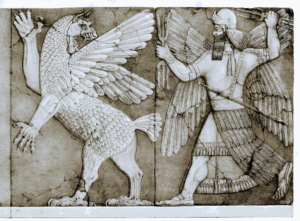
9 is a number, 3 is a number, but 10 is only a concept. It could represent 3 (in base 3) or 9 (in base 9). We use base 10, which means we don’t actually have a symbol for the number we call 10. In computer science, we often use base 16, or “hexadecimal”, since it is a multiple of base 2 (binary). We had to have symbols for the numbers after 9, so we use A, B, C, D, E, and F. In our heads, though, even we think “10” when we write hexadecimal “0A” and “16” when we write “10” in hexadecimal.
Sumerians
The Sumerians, ancient people we like to blame everything on, used base 12. Instead of using both hands to count to 10, they counted each segment of the fingers on one hand with their thumb, counting all the way to 12 on just one hand. Then they held up fingers on their other hand to count up to 5 iterations of counting to 12 on the first hand, counting all the way to 60 on two hands. The Babylonians copied that and then invented time. Well, not time, but our current system of measuring time, with lots of 12’s and 60’s in it.

Twelve is a fantastic and highly composite number, it’s fabulousness only exceeded by 60. Ten, on the other hand, is a real dud. Half of 10 is 5, but a 4th is fractional. And a 3rd and a 6th are not even finite decimals. So, why do we struggle along with such an inferior base? Zero, that’s why. Though the Sumerians and Babylonians picked much cooler base numbers, they never thought of having a symbol for zero. That means that to go higher than 12 or 60, they had to start counting toes and elbows and knees, and eventually they ran out of bits to count at around 360. Anything bigger than 360 was just “many”.
Zero is the Magic Number
The Hindu-Arabic number system we use today introduced a symbol for 0 to tack on to the end of any number to represent multiplying it by the base number. In other words, 10 is 1 times 10, 100 is 10 times 10, and 1000 is 100 times 10, with no fingers and toes needed.
The beauty of the new stacking “0” symbol is that it works for any base, including 12 or 60. Unfortunately for us, the truly inspired Hindu-Arabic folks that invented zero and our current number symbols somewhere around 500 A.D. did not use the better bases from the Sumerians and Babylonians who lived about 3000 years before their time. The thing to remember is that their world was much bigger while time was much shorter. Traveling beyond your own town, let alone to other countries and continents, was extremely rare. And for most, learning about history meant asking your grandparents.
How did we get Here from There?

Now here we are, with a numbering system that is a fabulous combination of brilliance and ignorance, plan and accident. Is this a nice metaphor for all that is, and all that we take for granted, a world built on arbitrary happenstance rather than natural law? How do we know what we don’t know or see what we aren’t looking for? What would a chair look like if our knees bent the other way? Maybe I go too far, but if counting to ten is not made of bedrock, what is?